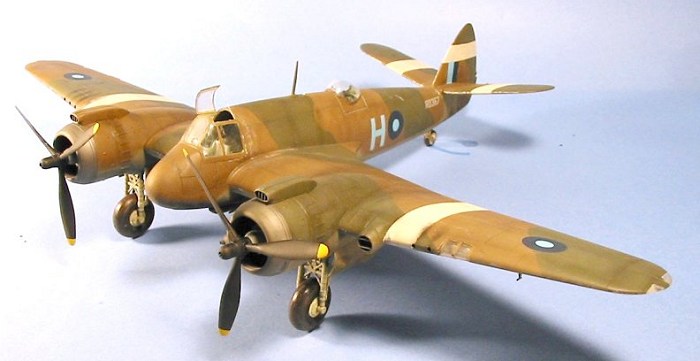
|
KIT: |
Tamiya 1/48 Beaufighter X |
|
KIT # |
? |
|
PRICE: |
$41.00 MSRP |
|
DECALS: |
Two options |
|
REVIEWER: |
Tom Cleaver |
|
NOTES: |
Cutting Edge decals used |

|
HISTORY |
Before the Second World War, the twin‑engine two seat fighter was seen primarily as a day interceptor, a task better fulfilled by the single‑seat single‑engine fighter. Germany created the Messerschmitt Bf‑110, which was found sadly deficient in speed, acceleration and maneuverability when ranged against smaller and lighter fighters in daylight.
In Britain just before the war, it was suddenly realized that there were other important tasks the large multi‑engine fighter could perform that its smaller counterparts could not. The result of the specification then issued was a piece of true British improvisation, the Bristol Beaufighter, which first entered service in late 1940.
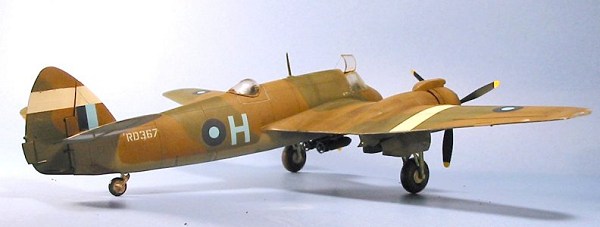 The Bristol
Aeroplane Company had foreseen this need; in 1938, L.G. Frise and his
team began what was essentially a fighter variant of the Beaufort
general‑reconnaissance and torpedo bomber. The economy of the proposal
was of obvious appeal to the RAF, and the first prototype flew July 17,
1939, two weeks after a production contract for 300 Beaufighters had been
placed.
The Bristol
Aeroplane Company had foreseen this need; in 1938, L.G. Frise and his
team began what was essentially a fighter variant of the Beaufort
general‑reconnaissance and torpedo bomber. The economy of the proposal
was of obvious appeal to the RAF, and the first prototype flew July 17,
1939, two weeks after a production contract for 300 Beaufighters had been
placed.
The Beaufighter IF arrived at the right time. British technology had created airborne radar, which needed a large airframe to carry the equipment and the weapons necessary to destroy the target. Beginning in November 1940 with 29 Squadron, the airplane became progressively responsible for the aerial defense of Britain by night, a task it performed admirably until replaced by the faster Mosquito beginning in 1943.
At the same time, Coastal Command discovered that a heavily‑ armed long‑range fighter for anti‑shipping strikes was just what it needed over the Bay of Biscay and the Mediterranean. 252 Squadron was the first Coastal Command squadron mounted on the Beaufighter. On April 4, 1943, the airplane added torpedo strike to its repertoire when two ships were sunk off Norway.
The success of the Mk. VIC "Torbeau"
led directly to the TF.X, which was powered by a modified version of the
Hercules VI engine having cropped impellers and the superchargers locked
in "M" ratio. These engines, designated Hercules XVII, proved 1,735 h.p.
at 500 feet, which gave the airplane its maximum performance at the low
altitudes at which Coastal Command operated its airplanes. The TF.X, the
last major production variant, passed through
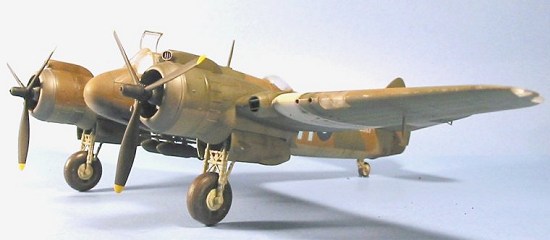 several important
modification stages without any change in its mark number. These
included the introduction of A.I. Mk. VIII radar in a "thimble" nose, and
later a large dorsal fin to provide the required directional stability.
several important
modification stages without any change in its mark number. These
included the introduction of A.I. Mk. VIII radar in a "thimble" nose, and
later a large dorsal fin to provide the required directional stability.
When the last Beaufighter (SR919) left the factory on September 21, 1945. 5,562 of Bristol's big twin had been produced in Great Britain. After the war, the airplane served with the air forces of Portugal and the Dominican Republic. As the TT.10 target tug, it flew with the RAF around the world until the last one went off service in May, 1960. The Beaufighter may have been an improvisation, but it was remarkably successful.
Beaufighters Over Burma:
The campaign in Burma between 1942-44 was the “forgotten war,” waged against a Japanese enemy that was strong enough to be a major threat as late as the Japanese invasion of India in 1944. Allied forces were always too few, always lesser-equipped than in other theaters, at least until 1944 when production of aircraft and other military equipment was such that the forces in the Southeast Asian Campaign could be turned into first-rate forces; the Arakan Campaign that began at the end of the monsoon in the fall of 1944 showed what was possible with properly-equipped forces.
One of the
first modern aircraft to arrive in India was the Beaufighter. The first
unit so equipped was 27 Squadron, which had served in India on the
North-West Frontier since 1920, equipped during the 1930s with Westland
Wapitis and hawker Harts. Equipped with Blenheim Mk.Is in February 1941,
27 moved to Singapore, then on to Butterworth in Malaya. In November
1941, it was annou8nced 27 would re-equip either with Marylands or
Beaufighters, but the Japanese attack the following month changed
everything. 27 was virtually wiped out as an operational unit on December
8, 1941. While eight
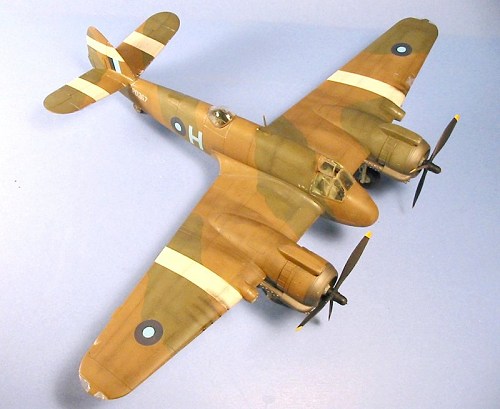 Blenheims managed to
take off to attack the Japanese landing at Khota Baru, an attack by
Ki.21s knocked out the remaining Blenheims and the Buffalos of 21
Squadron. By the end of the day, only 4 Blenheims were in shape to be
evacuated to Singapore on December 15. Evacuated to Sumatra in January
1942, the last Blenheim was destroyed in a Japanese air raid at
Jogjakarta on February 24, 1942. Evacuees aboard the SS “Khota Gehe”
managed to survive the Battle of Sunda Straits and finally arrived in
Ceylon on March 6, 1942. That September, the unit became the first in
Southeast Asia Command to equip with Beaufighter Mk.VI aircraft, crewed
by recent Commonwealth trainees and led by Wing Commander Henry Daish,
RAAF.
Blenheims managed to
take off to attack the Japanese landing at Khota Baru, an attack by
Ki.21s knocked out the remaining Blenheims and the Buffalos of 21
Squadron. By the end of the day, only 4 Blenheims were in shape to be
evacuated to Singapore on December 15. Evacuated to Sumatra in January
1942, the last Blenheim was destroyed in a Japanese air raid at
Jogjakarta on February 24, 1942. Evacuees aboard the SS “Khota Gehe”
managed to survive the Battle of Sunda Straits and finally arrived in
Ceylon on March 6, 1942. That September, the unit became the first in
Southeast Asia Command to equip with Beaufighter Mk.VI aircraft, crewed
by recent Commonwealth trainees and led by Wing Commander Henry Daish,
RAAF.
Throughout the Burma campaign, Beaufighters were used as long-range low-level strike aircraft against Japanese railroads, lines of communication, airfields and shipping, operating alone or in formations of two up to 500 miles from base. The silence of the Bristol Hercules engines, which gave the Beau the nickname “Whispering Death” over Burma served them well, since they would be virtually on top of the target before being heard on the ground. Becoming operational in December 1942, they were based at Agartala India for all of 1943 and early 1944. Operations in SEAC were primarily between mid-October to early May, with operations closing down during the monsoon that covered the region with cumulus clouds and squalls from May through the end of September each year, with combat flying becoming extremely dangerous due to the weather.
In August 1943, Wing Commander J.B. Nicholson, VC, assumed command of 27. As a Flying Officer, Nicholson became the only RAF fighter pilot in World War II to win the Victoria Cross shooting down a German fighter despite the fact his Hurricane had been set afire during the Battle of Britain. Despite the fact he could not use his badly-burned fingers and hands in the usual way, Nicholson was able to fly a Beaufighter with the best of them, and his example was inspirational to the rest of the aircrew during the year he commanded the unit, during which time another five squadrons joined 27 in operating Beaufighters over Burma.
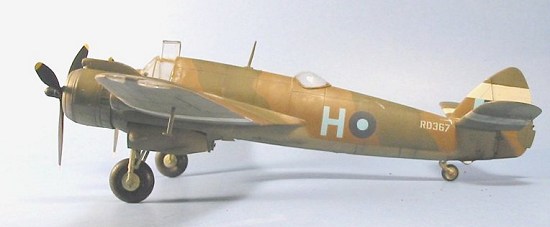 By March
1944, eight of the original 36 aircrew that had formed 27 on Beaufighters
remained with the unit, which was now equipped with the Beaufighter T.F.X,
the version optimized for low-level operations with special Hercules
engines that had cropped supercharger impellers. 27 were taken off
operations that month and began training to become part of a Beaufighter
strike wing similar to that formed at Banff in Scotland for anti-shipping
operations. Returning to combat in November 1944, the unit began using
rockets for strikes against Japanese shipping targets in support of the
invasion of Burma which began in December. In April 1945, the unit was
taken off operations and assigned to jungle air search and rescue duties,
which were undertaken until the end of the war in August.
By March
1944, eight of the original 36 aircrew that had formed 27 on Beaufighters
remained with the unit, which was now equipped with the Beaufighter T.F.X,
the version optimized for low-level operations with special Hercules
engines that had cropped supercharger impellers. 27 were taken off
operations that month and began training to become part of a Beaufighter
strike wing similar to that formed at Banff in Scotland for anti-shipping
operations. Returning to combat in November 1944, the unit began using
rockets for strikes against Japanese shipping targets in support of the
invasion of Burma which began in December. In April 1945, the unit was
taken off operations and assigned to jungle air search and rescue duties,
which were undertaken until the end of the war in August.
During 15 months of operations between December 1942-March 1944, 27 Squadron flew 397 missions - 337 in daylight and 60 at night, during which they destroyed over 200 locomotives, virtually ending Japanese use of the Burma railroads while destroying over 60 Japanese aircraft during airfield strikes. One DSO, three DFCs and one DFM were awarded the aircrew during these missions.
|
THE KIT |
Tamiya first
released its Beaufighter in June, 1997. Modelers in England were dismayed
that it was not as detailed asthey had hoped, and that there were several
things "wrong," most notably the elevator trim tab actuators, which were
on the wrong side of the horizontal stabilizer. There was nothing that
could not be solved with a modicum of modeling skill, and the
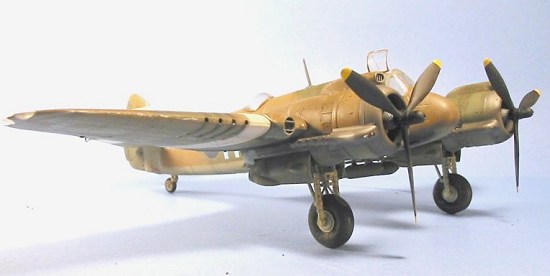 kit has been quite
successful. In its initial release, it came as a Mk. VI, but with the
"thimble" nose and the autopilot fairing of the Mk.21, it was not
difficult to make every version of the airplane other than the
Merlin‑powered Mk.II and the small‑elevator Mk. I; aftermarket sets were
released which allowed these versions to be built, also.
kit has been quite
successful. In its initial release, it came as a Mk. VI, but with the
"thimble" nose and the autopilot fairing of the Mk.21, it was not
difficult to make every version of the airplane other than the
Merlin‑powered Mk.II and the small‑elevator Mk. I; aftermarket sets were
released which allowed these versions to be built, also.
The new kit differs from the first version released by providing the larger rudder with the long dorsal fin, an 18" aerial torpedo and mounts, and two 500 lb. bombs and racks, which comes on a separate sprue.
Decals allow the modeler to make the well‑known early Mk. X, NT950 "T‑Tommy" of 236 Squadron, Banff Strike Wing, in attractive D‑Day markings, and "F‑Frankie" of 254 Squadron, also in the Banff Wing. While the instructions call for overall Extra Dark Sea Grey upper camouflage with Sky lower surfaces for both aircraft, I think from studying the well‑known set of air‑to‑air photos of T‑Tommy that the airplane had the earlier Coastal Command camouflage of Extra Dark Sea Grey/Slate Grey in a disruptive scheme over Sky lower surfaces.
|
CONSTRUCTION |
The Beaufighter is the product of Tamiya production design, and while it doesn’t assemble itself, there is no insurmountable problem in the task of assembly. The interior is not as fully-detailed as one might wish, but the result OOB is acceptable. For those who want more detail, Cutting Edge produces a Beaufighter cockpit in resin. I found I only needed to use filler on the fuselage centerline seam. I also trimmed off the solid plastic triangles that represent the trim tab actuators and replaced those with more accurate-looking parts using Evergreen sheet and rod.
|
COLORS AND MARKINGS |
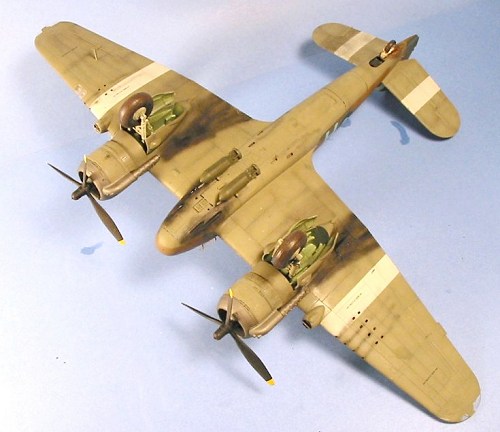 Painting:
Painting:
The Beaufighters used in SEAC were repainted from the factory-applied Temperate Sea Scheme to the Temperate Land Scheme of Dark Earth and Dark Green over Medium Sea Grey. I used Gunze-Sangyo paints for the upper surface and Tamiya “Medium Grey” for the lower color. The model was first pre-shaded with flat black along the panel lines, then the lower color was applied and masked off. The upper camouflage was done using masks made from drafting tape, with thread run along the edge 1/16" inboard, to provide a “hard” edge without having any paint buildup into a ridge as happens when the masking is applied directly to the edge of the pattern.
After I applied the camouflage, I masked off the cowlings and painted the exhaust collector with Model Master “Burnt Iron,” which was also used on the hedgehog exhausts. The cowlings were then glued to the model, having only been pushed into position during the camouflage painting.
Decals:
I used the Cutting Edge sheet 48057 “Beaufighter Part 1" to do Beaufighter T.F.X “H for Harry” of 27 Squadron.
|
FINAL CONSTRUCTION |
I used bomb racks and 500-lb bombs from the Tamiya Mosquito kit for the bomb racks on this Beaufighter. A photograph in David Innes’ autobiographical account “Beaufighters Over Burma” showed the newly-arrived and newly-painted “H for Harry” looking quite clean when it first arrived on the squadron in early 1944, and that was the scheme I did it as, with only exhaust stains underwing.
|
CONCLUSIONS |
Tamiya’s Beaufighter certainly has that big brutal look of the Beau, and provides a striking addition to any collection.
April 2004
Review kit courtesy of HobbyLink Japan.
If you would like your product reviewed fairly and quickly by a site that has nearly 250,000 visitors a month, please contact me or see other details in the Note to Contributors.